 |
ISA, Instruction Formats, Coding and Hand Assembly |
| << Measures of Performance SRC Features and Instruction Formats |
| Reverse Assembly, SRC in the form of RTL >> |
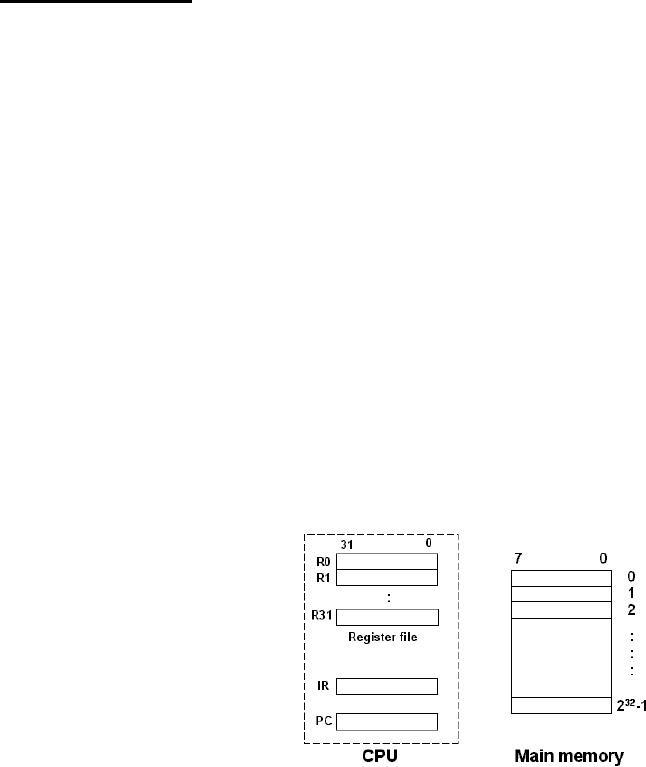
Advanced Computer
Architecture-CS501
Lecture
Handout
Computer
Architecture
Lecture
No. 4
Reading
Material
Vincent
P. Heuring&Harry F. Jordan
Chapter
2
Computer
Systems Design and Architecture
2.3,
2.4,slides
Summary
1)
Introduction to ISA and instruction
formats
2) Coding
examples and Hand
assembly
An example
computer: the SRC: "simple
RISC computer"
An
example machine is introduced here to
facilitate our understanding of
various design
steps and
concepts in computer architecture. This
example machine is quite
simple, and
leaves
out a lot of details of a
real machine, yet it is
complex enough to illustrate
the
fundamentals.
SRC
Introduction
Attributes
of the SRC
�
The SRC contains 32 General
Purpose Registers: R0, R1,
..., R31; each register
is
of size
32-bits.
�
Two special purpose registers are
included: Program Counter
(PC) and Instruction
Register
(IR)
�
Memory word size is 32
bits
�
Memory space size is 232 bytes
�
Memory organization is 232 x 8 bits, this means
that the memory is byte
aligned
�
Memory is accessed in 32
bit
words (
i.e., 4 byte chunks)
�
Big-endian byte storage is
used
Programmer's
View of the
SRC
The
figure below shows the
attributes
of the
SRC; the 32 ,32-bit registers
that
are a
part of the CPU, the
two
additional
CPU registers (PC & IR),
and the
main memory which is 232 1-
byte
cells.
Page
48
Last
Modified: 01-Nov-06
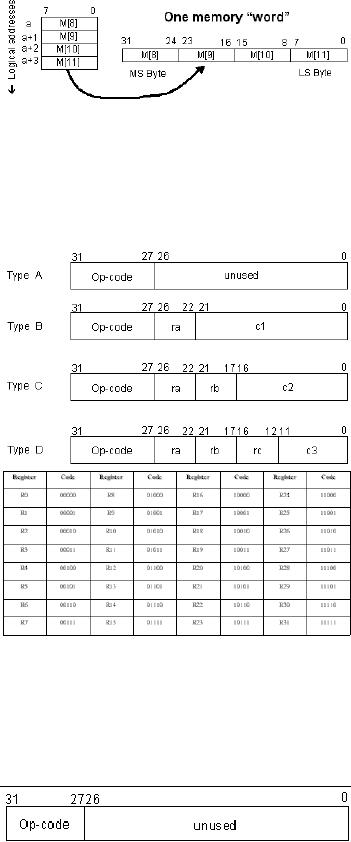
Advanced Computer
Architecture-CS501
SRC
Notation
We
examine the notation used
for the SRC with the
help of some
examples.
�
R[3] means contents of
register 3 (R for
register)
� M[8]
means contents of memory
location 8 (M for
memory)
� A
memory word at address 8
is
defined
as the 32 bits at
address
8,9,10
and 11 in the memory.
This is
shown in the figure
below.
� A special
notation for 32-bit
memory
words is
M[8]<31...0>:=M[8]M[9]M[10]M[11]
is used
for concatenation.
Some
more SRC
Attributes
� All
instructions are 32 bits
long (i.e., instruction size is 1
word)
� All ALU
instructions have three
operands
�
The only way to access
memory is through load and store
operations
�
Only a few addressing
modes
are
supported
SRC:
Instruction Formats
Four
types of instructions
are
supported
by the SRC.
Their
representation
is given in the
following
figure.
Before discussing
these
instruction
types in detail, we take a
look at
the encoding of
general-
purpose registers
(the ra, rb and rc
fields).
Encoding
of the General
Purpose
Registers
The
encoding for the general
purpose
registers is
shown in the
following
table; it
will be used in place of ra, rb
and rc in
the instruction formats
shown
above.
Note that this is a simple 5
bit
encoding.
ra, rb and rc are names of
fields used as "place-holders", and can
represent any
one of
these 32 registers. An exception is rb = 0; it
does not mean the register
R0, rather
it means
no operand. This will be explained in the
following discussion.
Type
A
Type A is
used for only two
instructions:
�
No
operation or nop, for
which
the
op-code = 0. This is useful
in
pipelining
�
Stop
operation stop, the op-code is 31
for this instruction.
Page
49
Last
Modified: 01-Nov-06
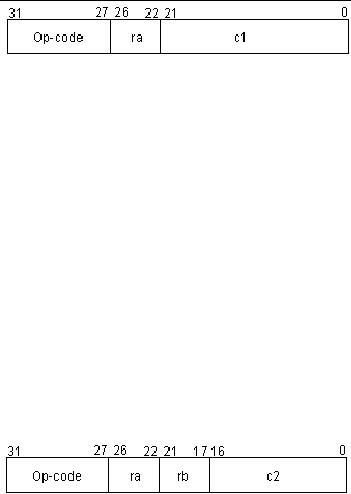
Advanced Computer
Architecture-CS501
Both of
these instructions do not
need an operand (are 0-operand
instructions).
Type
B
Type
B format includes
three
instructions;
all three use
relative
addressing
mode. These are
� The
ldr instruction, used to
load register from memory
using a relative
address.
(op-code
= 2).
o Example:
ldr
R3, 56
This
instruction will load the
register R3 with the
contents of the
memory
location
M [PC+56]
� The
lar instruction, for loading
a register with relative
address (op-code = 6)
o Example:
lar
R3, 56
This
instruction will load the
register R3 with the
relative address
itself
(PC+56).
� The
str is used to store register to
memory using relative
address (op-code = 4)
o Example:
str
R8, 34
This
instruction will store the register R8
contents to the memory
location
M
[PC+34]
The
effective address is computed at
run-time by adding a constant to
the PC. This
makes
the
instructions `re-locatable'.
Type
C
Type C
format has three
load/store
instructions,
plus
three
ALU
instructions.
These load/ store instructions
are
� ld,
the load register from
memory instruction (op-code =
1)
o Example
1:
ld R3,
56
This
instruction will load the
register R3 with the
contents of the
memory
location
M [56]; the rb field is 0 in
this instruction, i.e., it is
not used. This
is an
example of direct addressing
mode.
o Example
2:
ld R3,
56(R5)
The
contents of the memory
location M [56+R [5]] are
loaded to the
register
R3; the rb field ≠ 0. This
is an instance of indexed
addressing
mode.
� la is
the instruction to load a
register with an immediate
data value (which can
be
an
address) (op-code = 5 )
o Example1:
la R3,
56
The
register R3 is loaded with the
immediate value 56. This is
an instance
of
immediate addressing mode.
o Example
2:
la R3,
56(R5)
Page
50
Last
Modified: 01-Nov-06
Advanced Computer
Architecture-CS501
The
register R3 is loaded with the
indexed address 56+R [5].
This is an
example
of indexed addressing mode.
� The
st instruction is used to store register
contents to memory (op-code =
3)
o Example
1:
st R8,
34
This is
the direct addressing mode;
the contents of register R8 (R
[8]) are
stored to
the memory location M
[34]
o Example
2:
st R8,
34(R6)
An
instance of indexed addressing mode, M
[34+R [6]] stores the
contents
of R8(R
[8])
The ALU
instructions are
� addi,
immediate 2's complement
addition (op-code =
13)
o Example:
addi R3,
R4, 56
R[3]
←
R[4]+56
(rb
field = R4)
� andi,
the instruction to obtain
immediate logical AND,
(op-code = 21 )
o Example:
andi
R3, R4, 56
R3 is loaded
with the immediate logical
AND of the contents of
register
R4 and
56(constant value)
� ori,
the instruction to obtain
immediate logical OR (op-code = 23
)
o Example:
ori
R3, R4, 56
R3 is loaded
with the immediate logical
OR of the contents of register
R4
and
56(constant value)
Note:
1. Since
the constant c2 field is 17
bits,
For
direct addressing mode, only
the first 216 bytes of memory can
be
accessed (or the last
216 bytes if c2 is
negative)
In case
of the la instruction, only
constants with magnitudes
less
than
�216 can be loaded
During
address calculation using
c2, sign extension to 32
bits must
be
performed before the
addition
2. Type C
instructions, with some
modifications, may also be used
for
shift
instructions. Note
the
modification in the
following
figure.
The
four shift instructions
are
� shr
is the instruction used to
shift the bits right by
using value in (5-bit)
c3
field(shift
count) (op-code = 26)
o Example:
shr
R3, R4, 7
shift R4
right 7 times in to R3 and shifts zeros
in from the left as the
value
is
shifted right. Immediate
addressing mode is used.
� shra,
arithmetic shift right by
using value in c3 field
(op-code = 27)
o Example:
Page
51
Last
Modified: 01-Nov-06
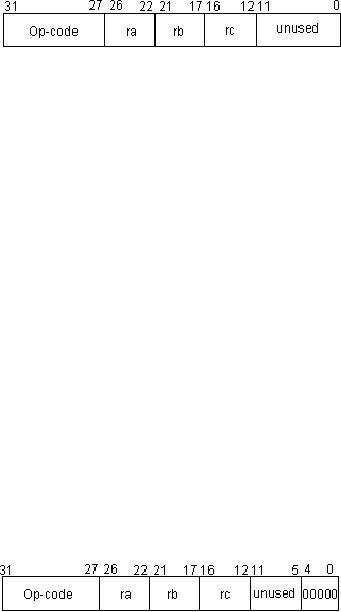
Advanced Computer
Architecture-CS501
shra R3,
R4, 7
This
instruction has the effect
of shift R4 right 7 times in to R3 and
copies
the msb
into the word on left as
contents are shifted right.
Immediate
addressing
mode is used.
�
The
shl instruction is for shift
left by using value in
(5-bit) c3 field (op-code =
28)
o Example:
shl
R8, R5, 6
shift R5
left 6 times in to R8 and shifts zeros in
from the right as the
value
is
shifted left. Immediate
addressing mode is used.
�
shc,
shift left circular by using
value in c3 field (op-code =
29)
o Example:
shc R3,
R4, 3
shift R4
circular 3 times in to R3 and copies
the value shifted out of
the
register
on the left is placed back into
the register on the right.
Immediate
addressing
mode is used.
Type
D
Type
D includes four
ALU
instructions,
four register based
shift
instructions,
two logical
instructions
and two
branch instructions.
The
four ALU instructions are
given below
� add,
the instruction for 2's
complement register addition
(op-code = 12)
o Example:
add
R3, R5, R6
result of
2's complement addition R[5]
+ R[6] is stored in R3.
Register
addressing
mode is used.
� sub ,
the instruction for 2's
complement register subtraction
(op-code = 14)
o Example:
sub R3,
R5, R6
R3 will store
the 2's complement
subtraction, R[5] - R[6].
Register
addressing
mode is used.
� and,
the instruction for logical
AND operation between registers (op-code
= 20)
o Example:
and R8,
R3, R4
R8 will store
the logical AND of registers R3 and R4.
Register addressing
mode is
used.
� or
,the instruction for logical
OR operation between registers (op-code =
22)
o Example:
or R8,
R3, R4
R8 is loaded
with the value R[3] v
R[4], the logical OR of registers R3
and
R4.
Register addressing mode is
used.
The
four register based shift
instructions use register
addressing mode. These use a
modified
form of type D, as shown
in
figure
� shr,
shift right by using value
in
register
rc (op-code = 26)
o Example:
Page
52
Last
Modified: 01-Nov-06
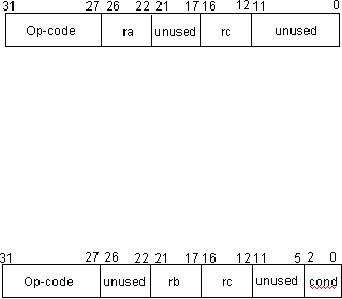
Advanced Computer
Architecture-CS501
shr
R3, R4, R5
This
instruction will shift R4 right in to R3
using number in R5
� shra,
the arithmetic shift right
by using register rc (op-code =
27)
o Example:
shra R3,
R4, R5
A shift
of R4 right using R5, and
the result is stored in R3
� shl
is shift left by using
register rc (op-code =
28)
o Example:
shl
R8, R5, R6
The
instruction shifts R5 left in to R8
using number in R6
� shc,
shifts left circular by
using register rc (op-code =
29)
o Example:
shc R3,
R4, R6
This
instruction will shift R4 circular in to
R3 using value in R6
The
two logical instructions also
use a modified form of the
Type D, and are the
following.
o neg
stores the 2's
complement
of
register rc in ra (op-code =
15)
o Example:
neg R3,
R4
Negates
(obtains 2's complement) of R4 and
stores in R3.
2-address
format
and register addressing mode is
used.
� not
stores
the 1's complement of
register rc in ra (op-code =
24)
o Example:
not
R3, R4
Logically
inverts R4 and stores in R3.
2-address format with
register
addressing
mode is
used.
Type D
has two-branch
instruction,
modified
forms of type D.
� br ,
the instruction to branch to
address in rb depending on the
condition in rc.
There
are five possible conditions,
explained through examples.
(op-code = 8).
All
branch instructions use
register-addressing mode.
o Example
1:
brzr
R3, R4
Branch to
address in R3 (if R4 == 0)
o Example
2:
brnz
R3, R4
Branch to
address in R3 (if R4 ≠ 0)
o Example
3:
brpl
R3, R4
Branch to
address in R3 (if R4 ≥ 0)
o Example
4:
brmi
R3, R4
Branch to
address in R3 (if R4 < 0)
o Example
5:
Page
53
Last
Modified: 01-Nov-06
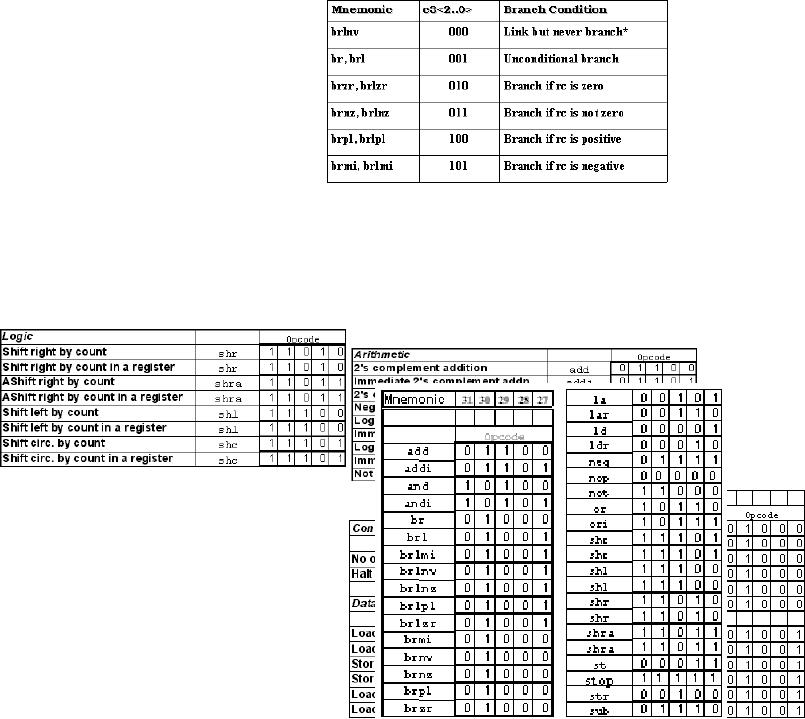
Advanced Computer
Architecture-CS501
br R3,
R4
Branch to
address in R3 (unconditional)
� Brl
the instruction to branch to
address in rb depending on condition in
rc.
Additionally,
it copies the PC in to ra before
branching (op-code = 9)
o Example
1:
brlzr
R1,R3, R4
R1 will store
the contents of PC, then
branch to address in R3 (if R4 ==
0)
o Example
2:
brlnz
R1,R3, R4
R1 stores
the contents of PC, then a
branch is taken, to address in R3
(if
R4 ≠ 0)
o Example
3:
brlpl
R1,R3, R4
R1 will store
PC, then branch to address
in R3 (if R4≥ 0)
o Example
4:
brlmi
R1,R3, R4
R1 will store PC and
then branch to address in R3
(if R4 < 0)
o Example
5:
brl
R1,R3, R4
R1 will store
PC, then it
will ALWAYS
branch to
address
in R3
o Example
6:
brlnv
R1,R3, R4
R1
just stores
the
contents
of PC but a
branch is
not taken
(NEVER
BRANCH)
In the
modified type D instructions
for branch, the bits
<2..0> are used for
specifying the
condition;
these condition codes are
shown in the table.
The
SRC Instruction
Summary
The
instructions implemented by the SRC
are listed, grouped on
functionality basis.
Functional
Groups of Instructions
Alphabetical
Listing based on
SRC
Mnemonics
Notice
that the op code field
for all br
instructions
is the same. The difference
is
in the
condition code field, which
is in
effect,
an op code extension.
Examples
Page
54
Last
Modified: 01-Nov-06
Advanced Computer
Architecture-CS501
Some
examples are studied in this
section to enhance the student's
understanding of the
SRC.
Example
1: Expression Evaluation
Write an
SRC assembly language program to
evaluate the
expression:
z =
4(a +b)
16(c+58)
Your
code should not change the
source operands.
Solution A:
Notice
that the SRC does not
have a multiply instruction. We will make
use
of the
fact that multiplication
with powers of 2 can be achieved by
repeated shift left
operations.
A possible solution is give
below:
ld R1,
c
; c is a
label used for a memory
location
addi R3,
R1, 58
; R3
contains (c+58)
shl
R7, R3, 4
; R7
contains 16(c+58)
ld R4,
a
ld R5,
b
add
R6, R4, R5
; R6
contains (a+b)
shl
R8, R6, 2
; R8
contains 4(a+b)
sub R9,
R7, R8
; the
result is in R9
st R9,
z
; store
the result in memory
location z
Note:
The
memory labels a, b, c and z can be
defined by using assembler
directives like .dw
or
.db,
etc. in the source
file.
A
semicolon `;' is used for
comments in assembly
language.
Solution
B:
We may
solve the problem by
assuming that a multiply
instruction, similar to the
add
instruction,
exists in the instruction
set of the SRC. The
shl instruction will be replaced
by the
mul instruction as given
below.
ld R1,
c
; c is a
label used for a memory
location
addi R3,
R1, 58
; R3
contains (c+58)
mul
R7, R3, 4
: R7
contains 16(c+58)
ld R4,
a
ld R5,
b
add
R6, R4, R5
; R6
contains (a+b)
mul
R8, R6, 2
; R8
contains 4(a+b)
sub R9,
R7, R8
; the
result is in R9
st R9,
z
; store
the result in memory
location z
Note:
The
memory labels a, b, c and z can be
defined by using assembler
directives like .dw
or
.db,
etc. in the source
file.
Solution
C:
We can
perform multiplication with a
multiplier that is not a
power of 2 by doing
addition
in a loop. The number of
times the loop will execute
will be equal to the
multiplier.
Example
2: Hand Assembly
Convert
the given SRC assembly
language program in to an equivalent SRC
machine
language
program.
ld R1,
c
; c is a
label used for a memory
location
addi R3,
R1, 58
; R3
contains (c+58)
Page
55
Last
Modified: 01-Nov-06
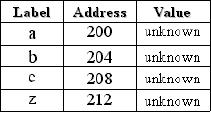
Advanced Computer
Architecture-CS501
shl
R7, R3, 4
; R7
contains 16(c+58)
ld R4,
a
ld R5,
b
add
R6, R4, R5
; R6
contains (a+b)
shl
R8, R6, 2
; R8
contains 4(a+b)
sub R9,
R7, R8
; the
result is in R9
st R9,
z
; store
the result in memory
location z
Note:
This
program uses memory labels
a,b,c and z. We need to define them
for the assembler
by using
assembler directives like
.dw or .equ etc. in the
source file.
Assembler
Directives
Assembler
directives, also called pseudo op-codes,
are commands to the
assembler to
direct
the assembly process. The
directives may be slightly
different for
different
assemblers.
All the necessary directives
are available with most
assemblers. We explain
the
directives as we encounter them.
More information on assemblers can be
looked up in
the
assembler user manuals.
Source
program with
directives
.ORG
200
; start
the next line at address
200
a:
.DW
1
; reserve one
word for the label a in
the memory
b:
.DW
1
; reserve a
word for b, this will be at
address 204
c:
.DW
1
; reserve a
word for c, will be at address
208
z:
.DW
1
; reserve one
word for the
result
.ORG
400
; start
the code at address
400
; all
numbers are in decimal
unless otherwise
stated
ld R1,
c
; c is a
label used for a memory
location
addi R3,
R1, 58 ; R3 contains
(c+58)
shl
R7, R3, 4
; R7
contains 16(c+58)
ld R4,
a
ld R5,
b
add
R6, R4, R5
; R6
contains (a+b)
shl
R8, R6, 2
; R8
contains 4(a+b)
sub R9,
R7, R8
; the
result is in R9
st R9,
z
; store
the result in memory
location z
This is
the way an assembly program
will appear in the source file.
Most assemblers
require
that the file be saved
with an .asm
extension.
Solution:
Observe
the first line of the
program
.ORG
200
;
start the next line at address
200
This is a
directive to let the
following code/ variables `originate' at
the specified address
of the
memory, 200 in this
case.
Variable
statements, and another .ORG directive
follow the .ORG
directive.
a:
.DW
1
; reserve one
word for the label a in
the memory
b:
.DW
1
; reserve a
word for b, this will be at
address 204
c:
.DW
1
; reserve a
word for c, will be at address
208
z:
.DW
1
; reserve one
word for the
result
.ORG
400
; start
the code at address
400
We
conclude the following from
the above statements:
Page
56
Last
Modified: 01-Nov-06
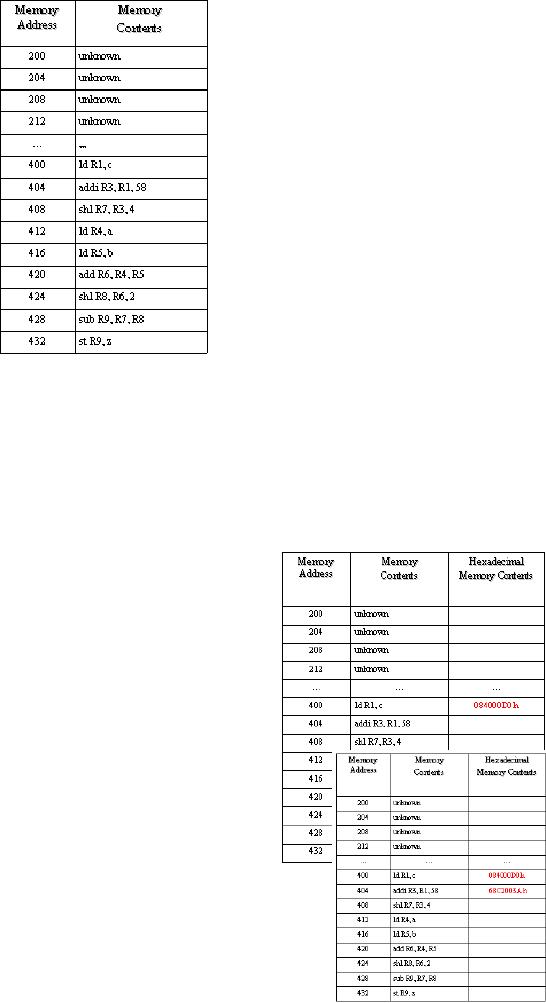
Advanced Computer
Architecture-CS501
The
code starts at address 400 and each
instruction takes 32 bits in
the memory. The
memory
map for the program is shown
in given table.
Memory
Map for the SRC example
program
We have
to convert these instructions to
machine language. Let us
start with the
first
instruction:
ld
R1, c
Notice
that this is a type C
instruction with the rb
field missing.
1. We
pick the op-code for this
load instruction from the
SRC instruction tables
given in
the SRC instruction summary
section. The op-code for the
load register
`ld'
instruction is 00001.
2. Next
we pick the register code
corresponding to register R1 from
the register table
(given in
the section `encoding of
general
purpose
registers'). The register
code for
R1 is
00001.
3. The rb
field is missing, so we place
zeros
in the
field: 00000
4. The
value of c is provided by
the
assembler, and
should be converted to 17
bits. As
c has been assigned the
memory
address
208, the binary value to
be
encoded
is 00000 0000 1101 0000.
5. So the
instruction ld R1, c is 00001
00001
00000 00000 0000 1101
0000 in the
machine
language.
6. The
hexadecimal representation of
this
instruction
is 0 8 4 0 0 0 D 0 h.
We can update
the memory map with
these
values.
We
consider the next
instruction,
Page
57
Last
Modified: 01-Nov-06

Advanced Computer
Architecture-CS501
addi
R3, R1, 58.
Notice
that this is a type C
instruction.
1. We
pick the op-code for the
instruction addi from the SRC
instruction table. It is
01101
2. We
pick the register codes
for the registers R3 and R1,
these codes are 00011
and
00001
respectively
3. For
the immediate data, 58, we
use the binary value, 00000
0000 0011 1010
4. So the
complete instruction becomes: 01101 00011
00001 00000 0000 0011 1010
5. The
hexadecimal representation of the
instruction
is 6 8 C 2 0 0 3 A
h
We update
the memory map, as shown in
table.
The
next instruction is shl
R7,R3, 4, at
address 408.
Again,
this is a type C
instruction.
1. The
op-code for the instruction
shl is picked from
the SRC
instruction table. It is 11100
2. The
register codes for the
registers R7 and R3
from
the register table are 00111
and 00011
respectively
3. For
the immediate data, 4, the
corresponding
binary
value 00000 0000 0000 0100 is
used.
4. We can place
these codes in accordance
with the
type C
instruction format to obtain
the complete instruction: 11100 00111
00011
00000 0000 0000
0100
5. The
hexadecimal representation of the
instruction is E1C60004
The
memory map is updated, as shown in
table.
The
next instruction, ld
R4, a, is also a
type C instruction.
Rb field
is missing in this instruction. To
obtain the
machine
equivalent, we follow the
steps given below.
1. The
op-code of the load instruction
`ld' is 00001
2. The
register code corresponding to
the register R4
is
obtained from the register
table, and it is 00100
3. As the
5 bit rb field is missing, we can
encode
zeros in
its place: 00000
4. The
value of a is provided by the assembler,
and
is
converted to 17 bits. It has
been assigned the
memory
address 200, the binary
equivalent of
which
is: 00000 0000 1100 1000
5. The
complete instruction becomes: 00001 00100
00000 00000 0000 1100 1000
6. The
hexadecimal equivalent of the
instruction is 0 9 0 0 0 0 C 8 h
Memory
map can be updated with this
value.
The
next instruction is also a load
type C instruction,
with
the rb
field missing.
ld
R5, b
The
machine language conversion
steps are
1. The
op-code of the load instruction is
obtained
from
the SRC instruction table; it is
00001
2. The
register code for R5,
obtained from the
register
table, is 00101
Page
58
Last
Modified: 01-Nov-06

Advanced Computer
Architecture-CS501
3. Again,
the 5 bit rb field is
missing. We encode zeros in its
place: 00000
4. The
value of label b is provided by
the assembler, and should be converted to
17
bits. It
has been assigned the
memory address 204, so the
binary value is:
00000
0000 1100
1100
5. The
complete instruction is: 00001 00101
00000 00000 0000 1100 1100
6. The
hexadecimal value of this
instruction is 0 9 4
000CCh
Memory
map is then updated with this
value.
The
next instruction is a type
D-add instruction, with
the
constant
field missing:
add
R6,R4,R5
The
steps followed to obtain the
assembly code for
this
instruction
are
1. The
op-code of the instruction is obtained
from
the SRC
instruction table; it is 01100
2. The
register codes for the
registers R6, R4 and R5
are
obtained from the register
table; these are
00110, 00100 and 00101
respectively.
3. The 12
bit constant field is unused
in this instruction, therefore we
encode zeros
in its
place: 0000 0000 0000
4. The
complete instruction becomes: 01100 00110
00100 00101 0000 0000 0000
5. The
hexadecimal value of the
instruction is 6 1 8 8 5 0 0 0 h
Memory
map is then updated with this
value.
The
instruction shl
R8,R6, 2 is a type
C instruction with
the rc
field missing. The steps
taken to obtain the
machine
code of the instruction
are
1. The
op-code of the shift left
instruction `shl',
obtained
from the SRC instruction
table, is 11100
2. The
register codes of R8 and R6 are 01000
and
00110
respectively
3. Binary
code is used for the
immediate data 2:
00000 0000 0000
0010
4. The
complete instruction becomes: 11100
01000
00110 00000 0000 0000
0010
5. The
hexadecimal equivalent of the
instruction is E
20C0002
Memory
map is then updated with this
value.
The
instruction at the memory
address 428 is sub
R9, R7, R8. This is
a type D
instruction.
We decode
it into the machine
language, as follows:
1. The
op-code of the subtract instruction
`sub' is
01110
2. The
register codes of R9, R7 and
R8, obtained
from
the register table, are
01001, 00111 and
01000
respectively
3. The 12
bit immediate data field is
not used, zeros
are
encoded in its place: 0000 0000
0000
Page
59
Last
Modified: 01-Nov-06
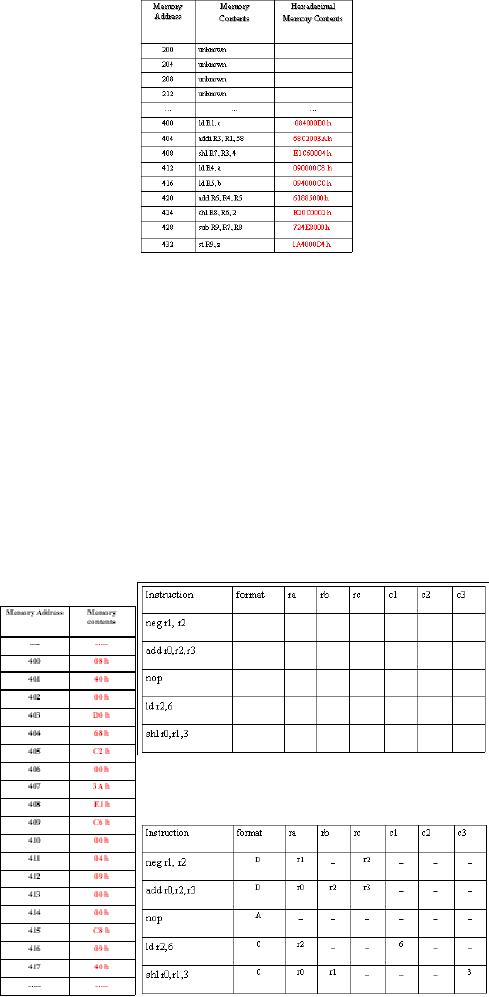
Advanced Computer
Architecture-CS501
4. The
complete instruction becomes: 01110 01001
00111 01000 0000 0000 0000
5. The
hexadecimal equivalent is 7 2 4 E 8 0 0 0
h
We again update
the memory map
The
last instruction is is a type C
instruction with the
rb
field
missing:
st
R9, z
The
machine equivalent of this
instruction is obtained
through
the following steps:
1. The
op-code of the store instruction `st',
obtained
from
the SRC instruction table, is
00011
2. The
register code of R9 is 01001
3. Notice
that there is no register
coded in the 5 bit
rb field,
therefore, we encode zeros:
00000
4. The
value of the label z is
provided by the
assembler, and
should be converted to 17
bits.
Notice
that the memory address
assigned to z is
212.
The 17 bit binary equivalent
is: 00000 0000
1101
0100
5. The
complete instruction becomes: 00011 01001
00000 00000 0000 1101 0100
6. The
hexadecimal form of this
instruction is 1 A 4 0 0 0 D 4 h
The
memory map, after the
conversion of all the
instructions, is
We have
shown the memory map as an
array of 4 byte cells in the
above solution.
However,
since the memory of the SRC is arranged
in 8 bit cells (i.e. memory
is byte
aligned),
the real representation of
the memory map is :
Example
3: SRC instruction
analysis
Identify
the formats of following SRC
instructions and specify the
values in the fields
Solution:
Page
60
Last
Modified: 01-Nov-06
Advanced Computer
Architecture-CS501
Page
61
Last
Modified: 01-Nov-06
Table of Contents:
- Computer Architecture, Organization and Design
- Foundations of Computer Architecture, RISC and CISC
- Measures of Performance SRC Features and Instruction Formats
- ISA, Instruction Formats, Coding and Hand Assembly
- Reverse Assembly, SRC in the form of RTL
- RTL to Describe the SRC, Register Transfer using Digital Logic Circuits
- Thinking Process for ISA Design
- Introduction to the ISA of the FALCON-A and Examples
- Behavioral Register Transfer Language for FALCON-A, The EAGLE
- The FALCON-E, Instruction Set Architecture Comparison
- CISC microprocessor:The Motorola MC68000, RISC Architecture:The SPARC
- Design Process, Uni-Bus implementation for the SRC, Structural RTL for the SRC instructions
- Structural RTL Description of the SRC and FALCON-A
- External FALCON-A CPU Interface
- Logic Design for the Uni-bus SRC, Control Signals Generation in SRC
- Control Unit, 2-Bus Implementation of the SRC Data Path
- 3-bus implementation for the SRC, Machine Exceptions, Reset
- SRC Exception Processing Mechanism, Pipelining, Pipeline Design
- Adapting SRC instructions for Pipelined, Control Signals
- SRC, RTL, Data Dependence Distance, Forwarding, Compiler Solution to Hazards
- Data Forwarding Hardware, Superscalar, VLIW Architecture
- Microprogramming, General Microcoded Controller, Horizontal and Vertical Schemes
- I/O Subsystems, Components, Memory Mapped vs Isolated, Serial and Parallel Transfers
- Designing Parallel Input Output Ports, SAD, NUXI, Address Decoder , Delay Interval
- Designing a Parallel Input Port, Memory Mapped Input Output Ports, wrap around, Data Bus Multiplexing
- Programmed Input Output for FALCON-A and SRC
- Programmed Input Output Driver for SRC, Input Output
- Comparison of Interrupt driven Input Output and Polling
- Preparing source files for FALSIM, FALCON-A assembly language techniques
- Nested Interrupts, Interrupt Mask, DMA
- Direct Memory Access - DMA
- Semiconductor Memory vs Hard Disk, Mechanical Delays and Flash Memory
- Hard Drive Technologies
- Arithmetic Logic Shift Unit - ALSU, Radix Conversion, Fixed Point Numbers
- Overflow, Implementations of the adder, Unsigned and Signed Multiplication
- NxN Crossbar Design for Barrel Rotator, IEEE Floating-Point, Addition, Subtraction, Multiplication, Division
- CPU to Memory Interface, Static RAM, One two Dimensional Memory Cells, Matrix and Tree Decoders
- Memory Modules, Read Only Memory, ROM, Cache
- Cache Organization and Functions, Cache Controller Logic, Cache Strategies
- Virtual Memory Organization
- DRAM, Pipelining, Pre-charging and Parallelism, Hit Rate and Miss Rate, Access Time, Cache
- Performance of I/O Subsystems, Server Utilization, Asynchronous I/O and operating system
- Difference between distributed computing and computer networks
- Physical Media, Shared Medium, Switched Medium, Network Topologies, Seven-layer OSI Model